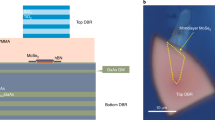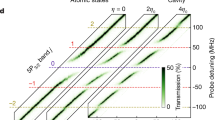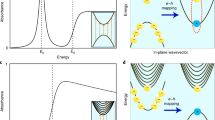Abstract
Coherent interaction of an ensemble of dipole active atoms or excitons with a vacuum electromagnetic field has been studied extensively since its initial conception by Dicke in 19541,2,3,4,5,6. However, when the emitters are not only periodically arranged as in refs 2 to 4, but are also placed in a periodically modulated dielectric environment, the interaction between them is carried by the electromagnetic Bloch waves of the photonic crystal7,8. Here we report the first observation of this effect using a periodic arrangement of GaAs/AlGaAs quantum wells. The formation of coherently coupled photonic-crystal excitonic-lattice polaritons manifests in our experiments through enhanced reflectivity and reconstruction of the photonic bandgap in the vicinity of the excitons. Experimental evidence of hybrid light hole–heavy hole excitonic-lattice polaritons is also presented. Coherent coupling between excitons and Bloch waves is established through comparisons of the experimental results with theory. Finally, we demonstrate the tuning of these polariton states by an electric field.
This is a preview of subscription content, access via your institution
Access options
Subscribe to this journal
Receive 12 print issues and online access
$209.00 per year
only $17.42 per issue
Buy this article
- Purchase on Springer Link
- Instant access to full article PDF
Prices may be subject to local taxes which are calculated during checkout





Similar content being viewed by others
References
Dicke, R. H. Coherence in spontaneous radiation processes. Phys. Rev. 93, 99–110 (1954).
Ivchenko, E. L., Nesvizhskii, A. I. & Jorda, S. Bragg reflection of light from quantum well structures. Phys. Solid State 36, 1156–1161 (1994).
Deutsch, I. H., Spreeuw, R. J. C., Rolston, S. L. & Phillips, W. D. Photonic band gaps in optical lattices. Phys. Rev. A 52, 1394–1410 (1995).
Hübner, M. et al. Optical lattices achieved by excitons in periodic quantum well structures. Phys. Rev. Lett. 83, 2841–2844 (1999).
Inouye, S. et al. Superradiant Rayleigh scattering from a Bose–Einstein condensate. Science 285, 571–574 (1999).
Scheibner, M. et al. Superradiance of quantum dots. Nature Phys. 3, 106–110 (2007).
Deych, L. I. & Lisyansky, A. A. Polariton dispersion law in periodic-Bragg and near-Bragg multiple quantum well structures. Phys. Rev. B 62, 4242–4244 (2000).
Sumioka, K., Nagahama, H. & Tsutsui, T. Strong coupling of exciton and photon modes in photonic crystal infiltrated with organic–inorganic layered perovskite. Appl. Phys. Lett. 78, 1328–1330 (2001).
Birkl, G., Gatzke, M., Deutsch, I. H., Rolston, S. L. & Phillips, W. D. Bragg scattering from atoms in optical lattices. Phys. Rev. Lett. 75, 2823–2826 (1995).
Ikawa, T. & Cho, K. Fate of the superradiant mode in a resonant Bragg reflector. Phys. Rev. B 66, 085338 (2002).
Werchner, M. et al. One dimensional resonant Fibonacci quasicrystals: noncanonical linear and canonical nonlinear effects. Opt. Express 17, 6813–6828 (2009).
Ivchenko, E. L. et al. Resonance optical spectroscopy of long-period quantum-well structures. Phys. Solid State 39, 1852–1858 (1997).
Ivchenko, E. L., Voronov, M. M., Erementchouk, M. V., Deych, L. I. & Lisyansky, A. A. Multiple-quantum-well-based photonic crystals with simple and compound elementary supercells. Phys. Rev. B 70, 195106 (2004).
Erementchouk, M. V., Deych, L. I. & Lisyansky, A. A. Optical properties of one-dimensional photonic crystals based on multiple-quantum-well structures. Phys. Rev. B 71, 235335 (2005).
Erementchouk, M. V., Deych, L. I. & Lisyansky, A. A. Spectral properties of exciton polaritons in one-dimensional resonant photonic crystals. Phys. Rev. B 73, 115321 (2006).
Biancalana, F., Mouchliadis, L., Creatore, C., Osborne, S. & Langbein, W. Microcavity polariton-like dispersion doublet in resonant Bragg gratings. Preprint at <http://arXiv:0904.0758v1> (2009).
Kavokin, A. V. & Kaliteevski, M. A. Light-absorption effect on Bragg interference in multilayer semiconductor heterostructures. J. Appl. Phys. 79, 595–598 (1996).
Ammerlahn, D. et al. Influence of the dielectric environment on the radiative lifetime of quantum-well excitons. Phys. Rev. B 61, 4801–4805 (2000).
Kasprzak, J. et al. Bose–Einstein condensation of exciton polaritons. Nature 443, 409–414 (2006).
Amo, A. et al. Collective fluid dynamics of a polariton condensate in a semiconductor microcavity. Nature 457, 291–296 (2009).
Gerace, D., Türeci, H. E., Imamoglu, A., Giovannetti, V. & Fazio, R. The quantum-optical Josephson interferometer. Nature Phys. 5, 281–284 (2009).
Balili, R., Hartwell, V., Snoke, D., Pfeiffer, L. & West, K. Bose–Einstein condensation of microcavity polaritons in a trap. Science 316, 1007–1010.
Saba, M. et al. High-temperature ultrafast polariton parametric amplification in semiconductor microcavities. Nature 414, 731–735 (2001).
Lidzey, D. G., Bradley, D. D. C., Armitage, A., Walker, S. & Skolnick, M. S. Photon-mediated hybridization of Frenkel excitons in organic semiconductor microcavities. Science 288, 1620–1623 (2000).
Erementchouk, M. V. Dispersion Law of Exciton Polaritons in MQW Based Photonic Crystals, vol. 5924, 59240R (SPIE, 2005).
Soubusta, J. et al. Excitonic photoluminescence in symmetric coupled double quantum wells subject to an external electric field. Phys. Rev. B 60, 7740–7743 (1999).
Westgaard, T., Zhao, Q. X., Fimland, B. O., Johannessen, K. & Johnsen, L. Optical properties of excitons in GaAs/Al0.3Ga0.7As symmetric double quantum wells. Phys. Rev. B 45, 1784–1792 (1992).
Linnerud, I. & Chao, K. A. Exciton binding energies and oscillator strengths in a symmetric AlxGa1−xAs/GaAs double quantum well. Phys. Rev. B 49, 8487–8490 (1994).
Acknowledgements
This work was supported by United States Air Force Office of Scientific Research (AFOSR) grant no. FA9550-07-1-0391.
Author information
Authors and Affiliations
Contributions
All authors have contributed to this paper and agree to its contents.
Corresponding author
Rights and permissions
About this article
Cite this article
Goldberg, D., Deych, L., Lisyansky, A. et al. Exciton-lattice polaritons in multiple-quantum-well-based photonic crystals. Nature Photon 3, 662–666 (2009). https://doi.org/10.1038/nphoton.2009.190
Received:
Accepted:
Published:
Issue Date:
DOI: https://doi.org/10.1038/nphoton.2009.190
This article is cited by
-
Numerical analysis of Bragg reflection spectra of GaAs/AlGaAs super-layers depending on hydrostatic pressure
Journal of Optics (2024)
-
Octet lattice-based plate for elastic wave control
Scientific Reports (2022)
-
Observation of Bragg polaritons in monolayer tungsten disulphide
Nano Research (2022)
-
Quantum Hall phases emerging from atom–photon interactions
npj Quantum Information (2021)
-
Supertransport of excitons in atomically thin organic semiconductors at the 2D quantum limit
Light: Science & Applications (2020)



